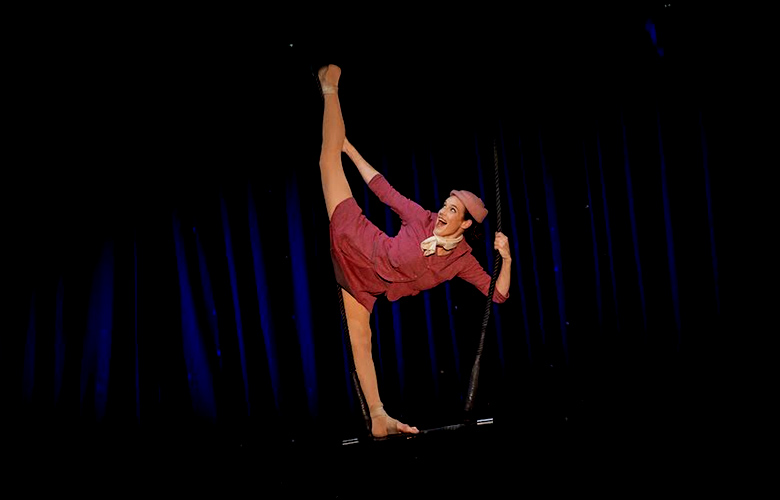
The stage is a partner, a tool, a workplace, and an invitation, all at once. Each artist develops a unique relation to it, one that evolves through time, space, and shows. No place is as versatile as this one and no other blank canvas can appear as dark, bright, or colorful. Just like personal relationships, some appear healthier or messier from the outside. 20 years into a non-monogamist relationship with the stage, Vancouver-born Anna Ward is far from wanting out of it.
“I’m at a place where I’m really analyzing what it is that I want to perform. I believe that artists must be able to stand behind what they present and I’m now reconsidering what I want to put out there.”
Inspired by Swiss-Italian director Daniele Finzi Pasca’s idea that artists must protect themselves and not show too much all at once, the circus artist points out that it’s so easy to give it all, on stage as in life, but finds that the most captivating stage performers are those who aren’t willing to give so much so easily.
“You can of course dig into who you are and build from it in cases where your street personality and stage persona collide, but knowing what to give and when to keep the mystery of who’s behind the character is a skill that takes a lifetime to master!” she concludes with one of those many instances where she’ll burst out laughing and throw her arms in the air.
With a hint of hilarity left in her voice, the circus artist shares that she’d spend hours on those “very high swings” at the playground growing up, endlessly trying to reach that one treetop. This exhilarating sensation definitely influenced her in moving to Montreal to become a professional swinging trapeze artist. Three years at the National Circus School shaped her, technically speaking at the very least, as she wasn’t a natural born acrobat. Paired with an amazingly generous and patient coach who took her under his wing, the inspired teenager was pushed and pushing herself to go beyond her limits.
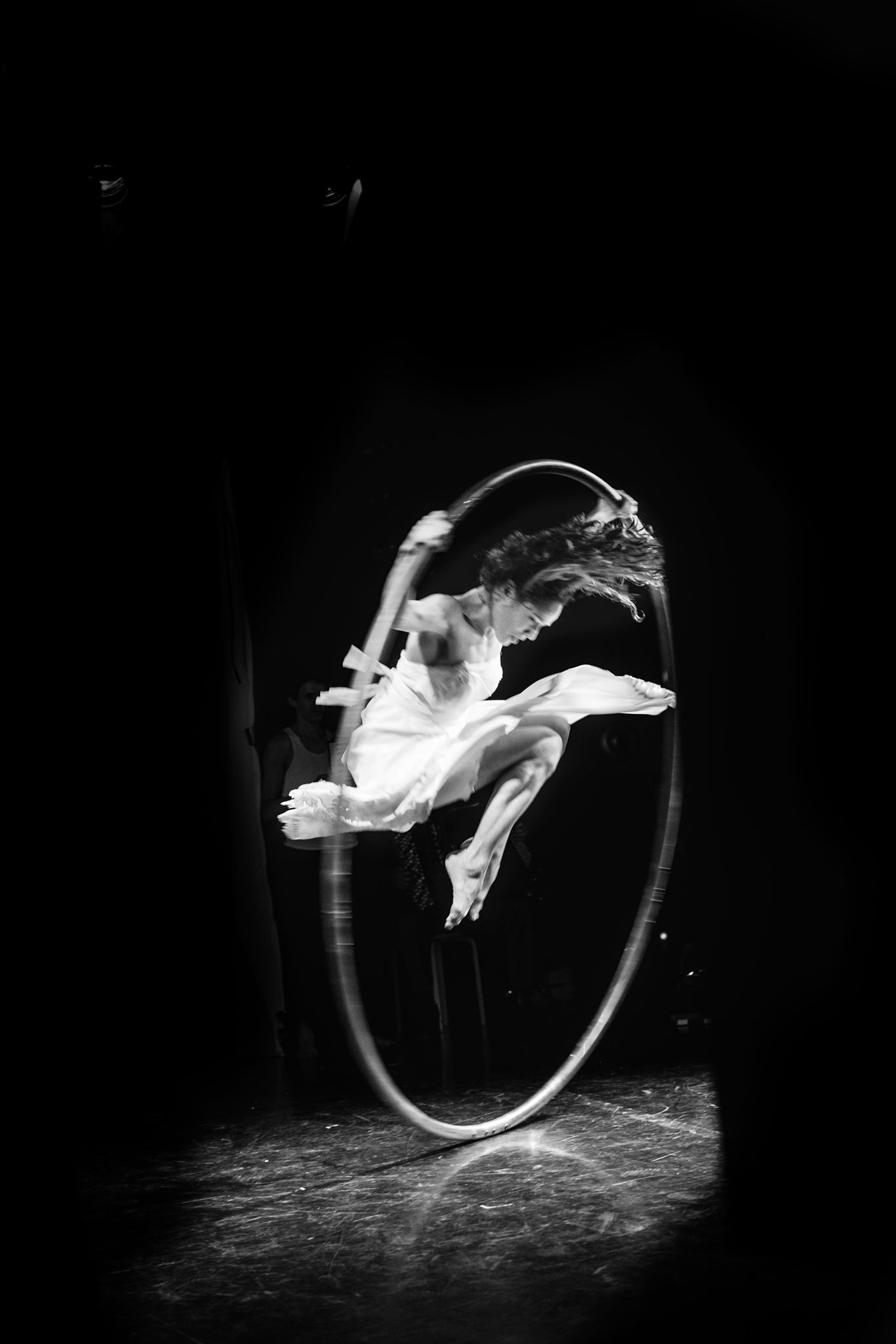
Considering and defining how to perform those skills in spite of the swinging trapeze’s constraints in terms of expressiveness would however turn out to be just as long a process, if not longer! Torn between technique, comedy, and expressiveness, the aerialist did not know how to choose nor combine them. Coming to terms with this discipline’s limitations to express what she wanted has been a very long journey. “Looking back, I don’t think I ever did!” she says in another spontaneous, honest laugh!
Finding and developing the ability to do the same thing every day on tour came as quite a shock, an unavoidable one in every artist’s relation to the stage in her opinion. If she feels that such sentiment is shared by many young artists nowadays, it really wasn’t the case during her training years.
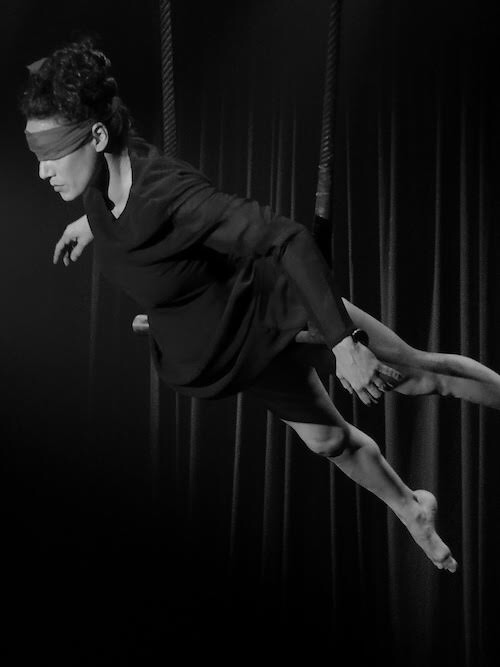
“Unlike in other art forms, it is rather uncommon to perform a circus piece a few times alone. You really need to go inside and find how subtext can and will come out differently each time you walk on stage to do your act… The same act as the night before and the one prior to that! It often is and feels similar, but remains relevant and challenging as long as it’s authentic.”
A few years of 8-to-10 weekly shows turned the newcomer into a seasoned professional, but one who was performing an act designed by others. A growing need to create her own work and express something very different led her from one of the world’s top entertainment companies to a small traveling circus. The crowds were smaller and the show felt far more intimate, especially in those moments where spectators could almost reach out and brush her in the middle of an arabesque! Having always enjoyed quiet, more intimate theatres over those busy Saturday night shows, this introvert was quite happy to perform a piece that was entirely hers for smaller crowds.
“It’s thanks to what I had learned from that Swiss tour that I was able to look at my work at Cirque du Soleil in a whole other way when I went back later on. I really worked to make this act as powerful as my very own creation.”
Even if the idea of taking her final bow at a pre-determined age never crossed her mind, the craving for a role with more character and expressiveness intertwined with the end of her swinging trapeze’s career. Warmth fills her voice and a few sparks illuminate her gaze even more as she recalls “La Notte Bianca.” One magical night in Rome where the sky felt wide with this breathtaking view of all those churches, stone walls, and so many people from her trapeze. Feeling incredibly light, the forty-years-old clearly recalls landing on the ground and knowing that she would be fine if this unique performance turned out to be her very last on that steel bar.
“And it was! Cirque Eloize approached me to audition for an acting part the very same week that Cirque du Soleil offered me another tour as a swinging trapeze artist. I was ready to move on and the choice really was clear. I wanted and needed to face a new challenge to grow and evolve as an artist and in my relation to the stage.”
Surrounded and supported by a cast and director that she describes as the greatest, most inspiring group of artists, she was allowed and expected to take the stage as someone else than “Trapeze Anna.” With a more serious, yet caring tone, she reminds artists that ‘an act is an act’ and that they have more to offer. Finding what they are craving and staying connected to what they want to offer are omnipresent parts of an artist’s relation to the stage and audience.
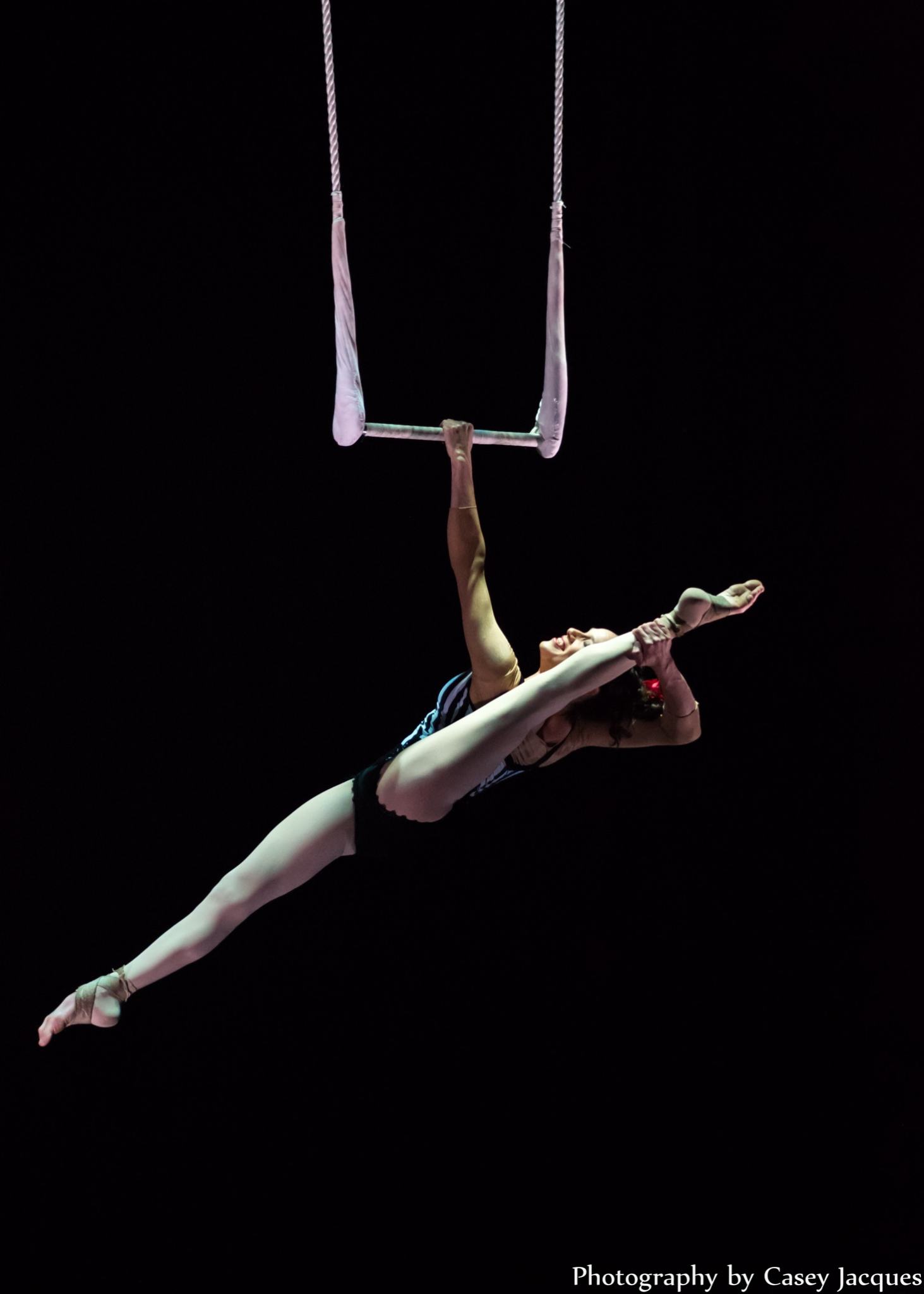
By relying on acting rather than aerial abilities to connect with the audience, the reborn artist was able to look at the stage and relate to it in an entirely different way. By exploring the ground with a new apparatus, the Cyr Wheel, she was able to go where she wanted as opposed to where the apparatus did, to stop when she felt like it and developed a more elaborated relation to space and the stage over the years.
“Ground artists also connect with the audience in very different ways. As a swinging act, you sort of take on the role of fireworks. Because you’re so far, it is more impressive than it is emotional. I’m able to go much further with a crowd who can really look at me and read the emotion on my face.”
Still smiling, but with her gaze wandering off towards the sun coming through the window, Anna shares that artists don’t have to do so much as even the tiniest gesture is captured and received by the audience. She freely admits that she has very often tried and gave more and more each time. However, there has to be a certain saturation limit. An artist cannot give endlessly, the same way that one can’t just keep on smelling once they’ve taken in all of someone’s scent. Understanding this reality and appreciating simplicity takes a certain amount of maturity according to the brunette.
“I’ve always been searching for expressivity through circus technique and am still looking for more, 20 years into this relation. I’m still feeling very nervous before each show! (HUGE laugh outburst!) My hands are still shaking before I go on, each time. It’s not the same nervousness every day, but it definitely fuels me.” Anna concludes with one last moment of laughter that she is nowhere close to retiring and has never thought of her career as “a job!”
Can a Voice last Beyond “The Voice”
Movie Trailers: Teasing or Spoiling?
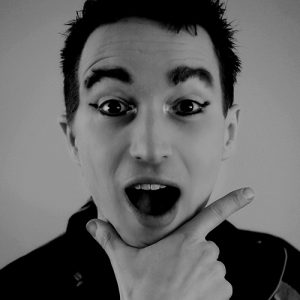

Impassioned by performing arts, Martin Frenette started intensive dance training at a very young age before trading pliés and barres for ropes and somersaults at Montreal's National Circus School. He has spent a decade in Europe, performing in various productions. Circus Monti, Chamäleon Theater, Wintergarten Varieté, Cirque Bouffon, GOP Show Concepts, and the Friedrichsbau Varieté have allowed him to grow artistically and humanly. Martin has also invested time working as an artistic consultant, director, and choreographer for both circus and dance projects. He enjoys splitting his time between Europe, Canada, and the US, working on stage and creating for others. Writing has always been a big passion of his and he's thrilled to share his views on shows, the stage, and what's going on behind the scenes with other performing arts enthusiasts!
Read Full Profile© 2021 TheatreArtLife. All rights reserved.

Thank you so much for reading, but you have now reached your free article limit for this month.
Our contributors are currently writing more articles for you to enjoy.
To keep reading, all you have to do is become a subscriber and then you can read unlimited articles anytime.
Your investment will help us continue to ignite connections across the globe in live entertainment and build this community for industry professionals.